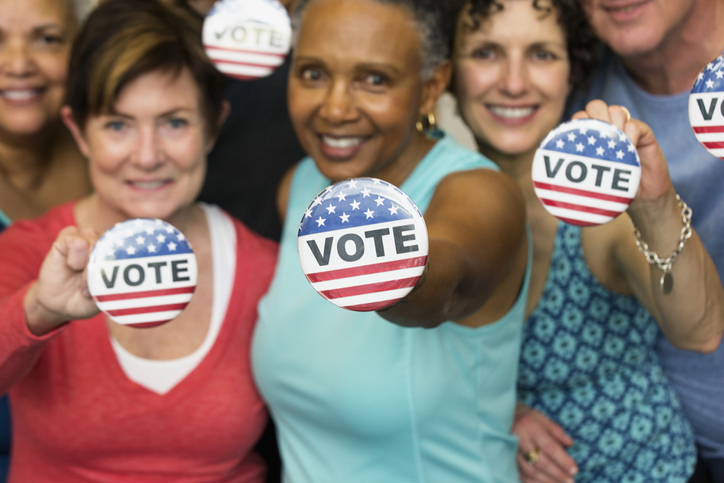
Challenges and Opportunities for Women Running for Office
Since Donald Trump was elected in 2016, we have seen women running for office at all levels of government at an unprecedented rate—and winning. We’ve written ultimate guides for running for office in the past, but running for office as a woman comes with a unique set of challenges and opportunities.
Before we jump right into the challenges and opportunities that come along with running for office as a woman, let’s take a moment to go through and celebrate the enormous increase we have seen in women running for office over the past four years:
- From 2016 to 2020, we have seen the number of women filing to run for Congress nearly double, from 312 women in 2016 to 529 women in 2018 to 575 women in 2020 (so far). Today, women make up 23.7% of Congress—not only up from 19.6% in 2016, but also a far greater share than at any other point in U.S. history.
- At the local and statewide levels, as of 2020, 28.9% of statewide executive offices are held by women (compared to 24% in 2016), 29.1% of state legislators are women (compared to 22.5% in 2016), and roughly 21% of mayors are women (compared to 18% in 2016).
- According to Emily’s List, an organization committed to electing female leaders, over 42,000 women expressed interest in running for office in 2018—that’s compared to 920 women in 2016.
- Of the women who have been elected to office across the country since 2016, we have seen several milestones, including Danica Roem (D-VA) becoming the first openly transgender person to serve in a state legislature, Sharice Davids (D-KS) and Deb Haaland (D-NM) becoming the first Native American women in Congress, Ilhan Omar (D-MN) and Rashida Tlaib (D-MI) becoming the first Muslim women in Congress, and Michelle Lujan Grisham becoming the first Democratic woman of color ever to be elected governor.
Challenges
Despite all the progress women have made in increasing their political representation, we still continue to face many challenges that male candidates do not have to handle. Below are some of the major hurdles that women running for office continue to face:
- Media coverage: Across both social media and traditional media, women continue to have a harder time receiving positive coverage. This is both in terms of quality and quantity—not only do women tend to get more negative coverage, but they also simply don’t get as much coverage as their male counterparts period. Not only does this hurt female candidates directly, but it also has a negative impact on women and girls who may be considering running themselves in the future.
- Fundraising challenges: As any current or former campaign worker may know, fundraising is arguably the most important part of any campaign. Without money, there is no campaign. Unfortunately, women running for office face a harder time raising money. Female candidates have pointed out that because they are underrepresented in the financial world, they have a harder time than their male counterparts connecting with and raising money from high-dollar donors, as they cannot break through the “lucrative boys’ clubs.”
- (Un)Likeability: Research has found that voters put a large amount of weight on the likeability of a candidate, or as it’s often put, which candidate they’d prefer to “have a beer with.” A study from the Barbara Lee Family Foundation shows that women have to try significantly harder not only to appear qualified, but also to be perceived as likeable. While voters use this metric to evaluate both male and female candidates, it has been found that only with female candidates is likability considered non-negotiable.
- Additional challenges for women of color: It’s also important to note that women of color running for office see an additional unique set of hurdles. For example, Oregon State Representative Janelle Bynum had the cops called on her while she was canvassing her district. According to A’shanti Gholar, the creator of the Brown Girls Guide to Politics, women of color can also have a harder time demonstrating viability to potential donors and are often criticized more for their demeanor than for their policy positions at public forums.
Opportunities
- When women do decide to run for office, they outperform men in elections. In 2018, 44% of non-incumbent Democratic women won their primaries, compared to 21% of non-incumbent Democratic men.
- Especially over the past few election cycles with Trump as president, it has been found that women running for office—and particularly, Democratic women running for office—can be successful in using a message of change, as the very fact that a woman is running for office is a challenge to the norm.
- When in office, women, put simply, are more effective. Not only do female representatives co-sponsor almost double the number of bills related to women’s health as compared to their male counterparts, but they also have been shown to get more bills enacted period. Additionally, on average, districts represented by women get $49 million more in federal funding annually than districts represented by men.
While women still face significant obstacles in running for office, we have come a long way. There are significant opportunities for women running for office to continue to win. Are you a woman considering a run for office? Check out our blog or get in touch!